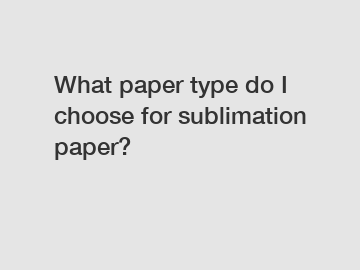What paper type do I choose for sublimation paper?
What Paper Type Do I Choose for Sublimation Paper?
When it comes to sublimation printing, the choice of paper type is crucial for obtaining high-quality results. There are various types of sublimation papers available on the market, each with its own unique characteristics and suitability for different applications. In this article, we will explore the different types of sublimation papers and discuss their advantages and disadvantages, enabling you to make an informed decision.
Sublimation paper is specially coated with a heat-sensitive layer that enables the transfer of dye onto various surfaces, such as fabric, ceramics, and metals. This unique coating allows the solid dye particles to convert into a gas state under high temperatures and bond with the receptive surface. As a result, sublimation printing offers vibrant and long-lasting designs that are resistant to fading or peeling.

The first type of sublimation paper we will discuss is the standard sublimation paper. This type is commonly used in various applications, including apparel, home decor, and promotional products. It provides a good balance between cost and quality, making it suitable for both small and large-scale production. Standard sublimation paper usually has a weight ranging from 80 to 100 gsm (grams per square meter), ensuring durability and excellent color transfer.
Another popular option is the heavyweight sublimation paper. As the name suggests, this type of paper has a higher weight, typically around 120 gsm. The heavyweight nature of this paper provides enhanced ink absorption and prevents ink bleeding, resulting in sharper and more vibrant prints. This makes it particularly suitable for intricate designs or images with a high level of detail.
For applications that require a more delicate touch, such as lightweight fabrics or materials with a smoother surface, lightweight sublimation paper is the ideal choice. This type of paper has a lower weight, usually around 60 to 70 gsm, allowing the dye to penetrate the surface more easily. Lightweight sublimation paper ensures that the design remains soft and flexible, making it perfect for garments or textiles that require a comfortable feel.
In addition to considering the weight, it is also essential to select the right coating for your specific application. The most common types of coatings for sublimation paper are instant-dry and high-tack coatings. The instant-dry coating allows the paper to dry quickly, enabling a faster production process. On the other hand, the high-tack coating provides superior adhesion, ensuring that the paper stays firmly in place during the heat transfer process.
Choosing the right type of sublimation paper greatly influences the final output of your sublimation prints. Using the appropriate paper ensures that the colors appear vivid and accurate, while also enhancing the durability and longevity of the design. Moreover, selecting the correct paper type for different applications improves the overall efficiency and cost-effectiveness of your sublimation printing processes.
To summarize, when choosing sublimation paper, consider factors such as weight, coating type, and the specific requirements of your application. Whether you opt for standard, heavyweight, or lightweight sublimation paper, always ensure that it is compatible with your printer and the substrates you plan to transfer the designs onto. By making the right choice, you can produce impressive sublimation prints that will captivate your audience and meet their expectations.
For more information, please visit quick dry sublimation paper, sublimation paper large format, sublimation paper for skis.

Comments